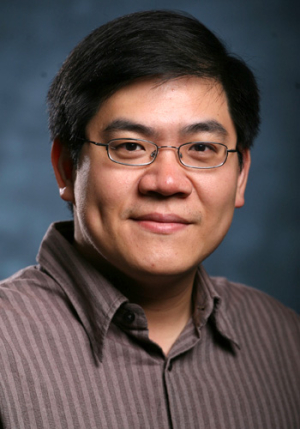Wei-Chuan Shih, assistant professor in the Cullen College’s Department of Electrical and Computer Engineering, has been recognized for his efforts to develop a new method of imaging groups of living cells.
Shih received the best poster award at the Advances in Optics for Biotechnology, Medicine and Surgery conference, held earlier this month in Naples, Fla., for his poster “High Throughput Chemical Imaging of Living Cells.” The poster outlined research he conducted in collaboration with fellow ECE professor Jack Wolfe, graduate students Ji Qi and Pratik Motwani, as well as Professor Timothy Devarenne and graduate student Taylor Weiss from Texas A&M University.
Shih’s poster detailed their efforts to advance an imaging technology known as Raman microscopy. This technique identifies chemicals (typically in or around cells or tissue) based on how they scatter light from a laser that is shined on them.
While effective, standard Raman microscopy is very slow. The laser is typically focused into a small point (measuring roughly 500 nm). It then scans an entire area following an XY-grid pattern. At one second per point and one-micron step size, imaging a 1002 micron2 area can take several hours.
Instead of scanning point by point, Shih’s Raman microscope scans line by line, equivalent in this case to imaging 100 points at each scanning step.
“The general idea is parallel acquisition. In our case, we project the laser into a line, then move that line across the area we want to image. That allows us to scan the same area in minutes instead of hours, and enables Raman microscopy to be applicable to live cell imaging over a large population,” he said.
By greatly speeding up Raman microscopy, Shih has made it a viable option for studying short-term cell dynamics in live cells. Shortening the imaging time from hours to minutes reduces problems caused by cellular motion and overcomes issues such as cells drying out.
Just as important is that this approach identifies cellular constituents based on their intrinsic molecular scattering. Currently, the most commonly used method of identifying cellular constituents in cell biology involves tagging them with a fluorescent label. High-throughput Raman microscopy avoids adding anything to the cells, leaving them intact and viable even after being studied.
Shih’s poster demonstrated the viability of this approach with images of algae genetically engineered to produce more hydrocarbons.
Using this high-throughput Raman microscopy technique, he was able to identify not just the hydrocarbons, but distinguish among the subtly different hydrocarbons in terms of the degree of methylation (the addition of a carbon/hydrogen molecules to a hydrocarbon chain) that gradually occurred in the algae.
Shih noted that this is just one example of how high-throughput Raman microscopy can be used. He is also exploring the technology’s use in diagnosing diseases, identifying different stages of cancer, and distinguishing specific bacteria from other cells.
